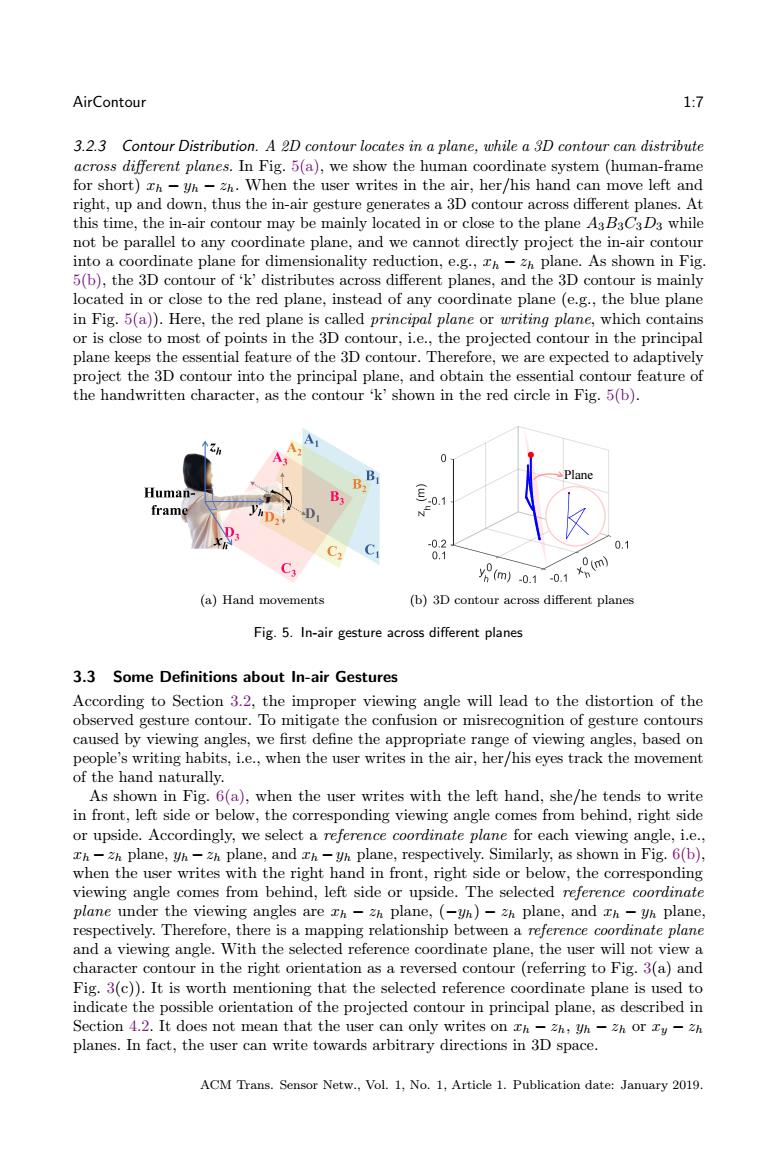正在加载图片...

AirContour 1:7 3.2.3 Contour Distribution.A 2D contour locates in a plane,while a 3D contour can distribute across different planes.In Fig.5(a),we show the human coordinate system (human-frame for short)ch-yh-zh.When the user writes in the air,her/his hand can move left and right,up and down,thus the in-air gesture generates a 3D contour across different planes.At this time,the in-air contour may be mainly located in or close to the plane A3B3C3D3 while not be parallel to any coordinate plane,and we cannot directly project the in-air contour into a coordinate plane for dimensionality reduction,e.g.,Th-Zh plane.As shown in Fig. 5(b),the 3D contour of 'k'distributes across different planes,and the 3D contour is mainly located in or close to the red plane,instead of any coordinate plane (e.g.,the blue plane in Fig.5(a)).Here,the red plane is called principal plane or writing plane,which contains or is close to most of points in the 3D contour,i.e.,the projected contour in the principal plane keeps the essential feature of the 3D contour.Therefore,we are expected to adaptively project the 3D contour into the principal plane,and obtain the essential contour feature of the handwritten character,as the contour 'k'shown in the red circle in Fig.5(b). 0 Plane B Human- B frame -02 C 0.1 0.1 C 8m)0.10.1 (m) (a)Hand movements (b)3D contour across different planes Fig.5.In-air gesture across different planes 3.3 Some Definitions about In-air Gestures According to Section 3.2,the improper viewing angle will lead to the distortion of the observed gesture contour.To mitigate the confusion or misrecognition of gesture contours caused by viewing angles,we first define the appropriate range of viewing angles,based on people's writing habits,i.e.,when the user writes in the air,her/his eyes track the movement of the hand naturally. As shown in Fig.6(a),when the user writes with the left hand,she/he tends to write in front,left side or below,the corresponding viewing angle comes from behind,right side or upside.Accordingly,we select a reference coordinate plane for each viewing angle,i.e., Th-Zh plane,yh-zh plane,and Th-yh plane,respectively.Similarly,as shown in Fig.6(b), when the user writes with the right hand in front,right side or below,the corresponding viewing angle comes from behind,left side or upside.The selected reference coordinate plane under the viewing angles are xh-zh plane,(-yh)-zh plane,and Ih-yh plane, respectively.Therefore,there is a mapping relationship between a reference coordinate plane and a viewing angle.With the selected reference coordinate plane,the user will not view a character contour in the right orientation as a reversed contour(referring to Fig.3(a)and Fig.3(c)).It is worth mentioning that the selected reference coordinate plane is used to indicate the possible orientation of the projected contour in principal plane,as described in Section 4.2.It does not mean that the user can only writes on Th-zh,yh-Zh or y-Zh planes.In fact,the user can write towards arbitrary directions in 3D space. ACM Trans.Sensor Netw.,Vol.1,No.1,Article 1.Publication date:January 2019.AirContour 1:7 3.2.3 Contour Distribution. A 2D contour locates in a plane, while a 3D contour can distribute across different planes. In Fig. 5(a), we show the human coordinate system (human-frame for short) 𝑥ℎ − 𝑦ℎ − 𝑧ℎ. When the user writes in the air, her/his hand can move left and right, up and down, thus the in-air gesture generates a 3D contour across different planes. At this time, the in-air contour may be mainly located in or close to the plane 𝐴3𝐵3𝐶3𝐷3 while not be parallel to any coordinate plane, and we cannot directly project the in-air contour into a coordinate plane for dimensionality reduction, e.g., 𝑥ℎ − 𝑧ℎ plane. As shown in Fig. 5(b), the 3D contour of ‘k’ distributes across different planes, and the 3D contour is mainly located in or close to the red plane, instead of any coordinate plane (e.g., the blue plane in Fig. 5(a)). Here, the red plane is called principal plane or writing plane, which contains or is close to most of points in the 3D contour, i.e., the projected contour in the principal plane keeps the essential feature of the 3D contour. Therefore, we are expected to adaptively project the 3D contour into the principal plane, and obtain the essential contour feature of the handwritten character, as the contour ‘k’ shown in the red circle in Fig. 5(b). (a) Hand movements Plane (b) 3D contour across different planes Fig. 5. In-air gesture across different planes 3.3 Some Definitions about In-air Gestures According to Section 3.2, the improper viewing angle will lead to the distortion of the observed gesture contour. To mitigate the confusion or misrecognition of gesture contours caused by viewing angles, we first define the appropriate range of viewing angles, based on people’s writing habits, i.e., when the user writes in the air, her/his eyes track the movement of the hand naturally. As shown in Fig. 6(a), when the user writes with the left hand, she/he tends to write in front, left side or below, the corresponding viewing angle comes from behind, right side or upside. Accordingly, we select a reference coordinate plane for each viewing angle, i.e., 𝑥ℎ −𝑧ℎ plane, 𝑦ℎ −𝑧ℎ plane, and 𝑥ℎ −𝑦ℎ plane, respectively. Similarly, as shown in Fig. 6(b), when the user writes with the right hand in front, right side or below, the corresponding viewing angle comes from behind, left side or upside. The selected reference coordinate plane under the viewing angles are 𝑥ℎ − 𝑧ℎ plane, (−𝑦ℎ) − 𝑧ℎ plane, and 𝑥ℎ − 𝑦ℎ plane, respectively. Therefore, there is a mapping relationship between a reference coordinate plane and a viewing angle. With the selected reference coordinate plane, the user will not view a character contour in the right orientation as a reversed contour (referring to Fig. 3(a) and Fig. 3(c)). It is worth mentioning that the selected reference coordinate plane is used to indicate the possible orientation of the projected contour in principal plane, as described in Section 4.2. It does not mean that the user can only writes on 𝑥ℎ − 𝑧ℎ, 𝑦ℎ − 𝑧ℎ or 𝑥𝑦 − 𝑧ℎ planes. In fact, the user can write towards arbitrary directions in 3D space. ACM Trans. Sensor Netw., Vol. 1, No. 1, Article 1. Publication date: January 2019